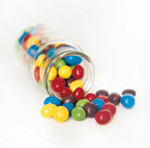Barbara Kahn calls them candy jungles – the bulk confection stores that have become fixtures at American shopping malls. Clear plastic bins line the walls from top to bottom, the Swedish fish, sour peach chews, florescent watermelon gummy worms and jelly beans creating vivid, vertical slashes of neon across white walls. Big-eyed kids scramble to fill small cellophane bags that never seem in short supply.
“When you go into these stores, it’s kind of like a Chinese restaurant,” says Kahn, a Wharton marketing professor and the author of numerous studies on supermarket and food marketing. “It seems like there’s a whole lot going on. But if you look more carefully, you see that there’s really a lot of repetition. There are three different kinds of red jellies, for instance; they are just cut in different shapes.”
Kahn was intrigued by these candy smorgasbords and by the somewhat frenzied response consumers seem to have to them. Do people buy more, she wondered, when they see what looks like unlimited variety? Does creating a visual perception of activity and an abundance of choices ultimately increase consumption?
It does, Kahn found after conducting a series of experiments that she and University of Illinois professor Brian Wansink are publishing in a forthcoming issue of Journal of Consumer Research. Their work, titled “The Influence of Assortment Structure on Perceived Variety and Consumption Quantities,” found that the perception of variety, even when illusory, stimulates people to consume more. Kahn’s and Wansink’s research reinforces other recent studies challenging long-held views that a person’s ability to control eating, spending and general overindulgence has solely to do with willpower, or a lack thereof. Environmental factors, including portion size, price and the number of choices presented, also play a key role in America’s well-documented passion for overindulgence, social scientists are now finding.
An earlier study by co-author Wansink, for example, found that movie-goers given an extra-large bucket of popcorn will eat 45% to 50% more than those given a container one size smaller, even when the popcorn is stale. Hungry or not, another study found, employees will eat throughout their workday if an office table is stocked with cookies and candy, while other research revealed that the bigger the toothbrush head, the more toothpaste people use. And when consumers are offered an assortment with three different flavors of yogurt, they consume an average of 23% more than from a collection of just one flavor.
The present study by Kahn and Wansink adds a subtle new twist. “It is widely assumed across disciplines that increasing the actual variety of an assortment can increase the quantity consumed,” they write. “We show, however, that perceived variety can also influence consumption even when actual variety is unchanged.”
It’s all about cues, says Kahn, who feels strongly that, in the face of rising obesity and its related health problems, consumers need to become more conscious that marketing tools may be affecting their behavior. “People are often surprised at how much they consume, and this indicates they may be influenced at a basic or perceptual level” which they are not aware of, Kahn and Wansink write.
The paper describes the outcome of six individual field experiments that show how consumption is influenced by the organization, size and entropy (degree of disorder) of a product assortment. In one experiment, for instance, the researchers changed the organization of 24 types of jelly beans, measuring people’s consumption when the candy was carefully organized, then when it was messy and scrambled. Interestingly, people ate more of the organized jelly beans than the scrambled ones.
But when Kahn and Wansink offered subjects just six jelly bean flavors, they ate significantly more of the scrambled assortment. “That’s what we mean by perceived variety. It’s related to the number, but it’s also a function of how the assortment is displayed. When a smaller variety of colors is scrambled, it looks like there’s a lot more variety than there is. When there appears to be more variety, it seems to make sense to take more,” Kahn says.
And while it’s important for researchers, food retailers and manufacturers to know that the mere perception of variety can influence consumption, this “mindless influence” over consumers, Kahn says, is a key practical implication of the research. Studies have shown that people have less self-control when they are less able to monitor their behavior. For dieters, diabetics or others struggling with eating less, understanding that a party tray crammed with hors d’oeuvres or a jar filled with jelly beans might challenge this self-control is an important step toward limiting consumption. Something as simple as not duplicating offerings at holiday dinners – putting all of the mashed potatoes in one large bowl rather than three smaller ones – can also help. “At buffets it’s not just how much food there is, it’s how much perceived variety there is,” Kahn says.
Conversely, hospital or nursing home dieticians, or even parents of children with finicky eating habits, can assemble smaller helpings of more items in an effort to stimulate the appetites of those under their care.
Should fast-food chains and food manufacturers, now facing a tide of lawsuits from trial lawyers claiming their culpability in the U.S. obesity epidemic, bear some of the blame? Kahn says it’s clearly in the customers’ best interest to promote healthy lifestyles. “Since I believe in many situations people eat based on consumption cues rather than hunger, fast-food chains and manufacturers, at the very least, can easily be a part of the solution.
“The normal economic model would be that you eat when you are hungry or that you buy things that you need and that you don’t buy things that you don’t need. But we don’t think people really know how to eat today – they look for cues. And most people don’t realize that an assortment of a product encourages them to take more. We are all mindlessly making a lot of decisions.”


